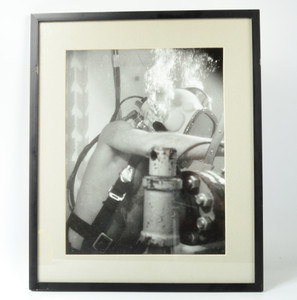Vintage Diver Underwater Hazard Study Using Human Subjects. Framed 10x13 Photo
This a framed and matted photograph frame taken during a series of predictive studies from 1970-1971. This study focused on A 14-day, continuous dry-chamber exposure to normoxic N2 at 100 FSW (4 ATA). Collaborating sponsors: U. Penn, NASA, Navy BUMED, ONR, NIH, Baylor U.
The purpose of the Predictive Studies Series was to correlate physiologic responses to extreme environmental stresses. Some information on this study:
"Predictive Studies II, a 14-day, dry-chamber, continuous exposure to normoxic nitrogen at 100 fsw, or 4 ATA (18-25), was the first study to be done in a new environmental chamber system of the present Institute for Environmental Medicine at the University of Pennsylvania (18). The study was stimulated by the recognition that the potential benefits of manned undersea activity would be greatly enhanced by an ability to remain for extended periods at shallow and moderate depths, where much of the useful undersea work is performed. Areas of investigation considered likely to identify physiological responses or mechanisms that could potentially limit human tolerance or adaptation to increased atmospheric pressures included:
• Combined effects of increased work of breathing and nitrogen narcosis on respiratory control and pulmonary gas exchange.
• Effects of acute and sustained exposure to increased breathing resistance on pulmonary mechanical and other functions.
• Rates of adaptation to stresses imposed on pulmonary function and respiratory control, as well as rates of deterioration at rest and during exercise in the event that adaptations fail.
• Quantitative decrements, adaptations, and deteriorations in specific aspects of mental performance during acute and chronic exposure to nitrogen narcosis.
• Nitrogen influences on formation and destruction of blood cellular constituents.
• Patterns of chemical, endocrine, and metabolic adaptations during prolonged exposures to increased nitrogen pressure.
No serious, acute or chronic, toxic or nitrogen narcotic limiting effects developed during the 14-day exposure. Adaptation of respiratory control was manifested by a decreased ventilatory response to carbon dioxide, which did not interfere significantly with pulmonary gas exchange or
progress with time (21). The respiratory muscles compensated for an increased work of breathing, thereby allowing exercise tolerance to remain high with adequate gas exchange. Cognitive function and technical competence remained more than adequate for the detailed
experimental procedures carried out by and with the subjects. Quantitative measurements of mental function did not detect progressive deteriorations or adaptations to nitrogen narcosis (25). There were no alterations in blood cell formation or aging (22), or any limiting chemical,
metabolic, or endocrine dysfunction (23). Plasma volume decreased concurrently with an increased urine output, but these changes were not functionally significant (24)"
Photo shows Predictive Studies II (1970-1971) Exercise Function. A 14-day, continuous dry-chamber exposure to normoxic N2 at 100 FSW (4 ATA).
Photograph Size: 10" X 13"
Frame Size: 14 11/16" x 17 3/4"
Condition
------------
Excellent condition. Frame has few dings and wear marks on it. Photo is in great condition with minimal fading.
This a framed and matted photograph frame taken during a series of predictive studies from 1970-1971. This study focused on A 14-day, continuous dry-chamber exposure to normoxic N2 at 100 FSW (4 ATA). Collaborating sponsors: U. Penn, NASA, Navy BUMED, ONR, NIH, Baylor U.
The purpose of the Predictive Studies Series was to correlate physiologic responses to extreme environmental stresses. Some information on this study:
"Predictive Studies II, a 14-day, dry-chamber, continuous exposure to normoxic nitrogen at 100 fsw, or 4 ATA (18-25), was the first study to be done in a new environmental chamber system of the present Institute for Environmental Medicine at the University of Pennsylvania (18). The study was stimulated by the recognition that the potential benefits of manned undersea activity would be greatly enhanced by an ability to remain for extended periods at shallow and moderate depths, where much of the useful undersea work is performed. Areas of investigation considered likely to identify physiological responses or mechanisms that could potentially limit human tolerance or adaptation to increased atmospheric pressures included:
• Combined effects of increased work of breathing and nitrogen narcosis on respiratory control and pulmonary gas exchange.
• Effects of acute and sustained exposure to increased breathing resistance on pulmonary mechanical and other functions.
• Rates of adaptation to stresses imposed on pulmonary function and respiratory control, as well as rates of deterioration at rest and during exercise in the event that adaptations fail.
• Quantitative decrements, adaptations, and deteriorations in specific aspects of mental performance during acute and chronic exposure to nitrogen narcosis.
• Nitrogen influences on formation and destruction of blood cellular constituents.
• Patterns of chemical, endocrine, and metabolic adaptations during prolonged exposures to increased nitrogen pressure.
No serious, acute or chronic, toxic or nitrogen narcotic limiting effects developed during the 14-day exposure. Adaptation of respiratory control was manifested by a decreased ventilatory response to carbon dioxide, which did not interfere significantly with pulmonary gas exchange or
progress with time (21). The respiratory muscles compensated for an increased work of breathing, thereby allowing exercise tolerance to remain high with adequate gas exchange. Cognitive function and technical competence remained more than adequate for the detailed
experimental procedures carried out by and with the subjects. Quantitative measurements of mental function did not detect progressive deteriorations or adaptations to nitrogen narcosis (25). There were no alterations in blood cell formation or aging (22), or any limiting chemical,
metabolic, or endocrine dysfunction (23). Plasma volume decreased concurrently with an increased urine output, but these changes were not functionally significant (24)"
Photo shows Predictive Studies II (1970-1971) Exercise Function. A 14-day, continuous dry-chamber exposure to normoxic N2 at 100 FSW (4 ATA).
Photograph Size: 10" X 13"
Frame Size: 14 11/16" x 17 3/4"
Condition
------------
Excellent condition. Frame has few dings and wear marks on it. Photo is in great condition with minimal fading.










